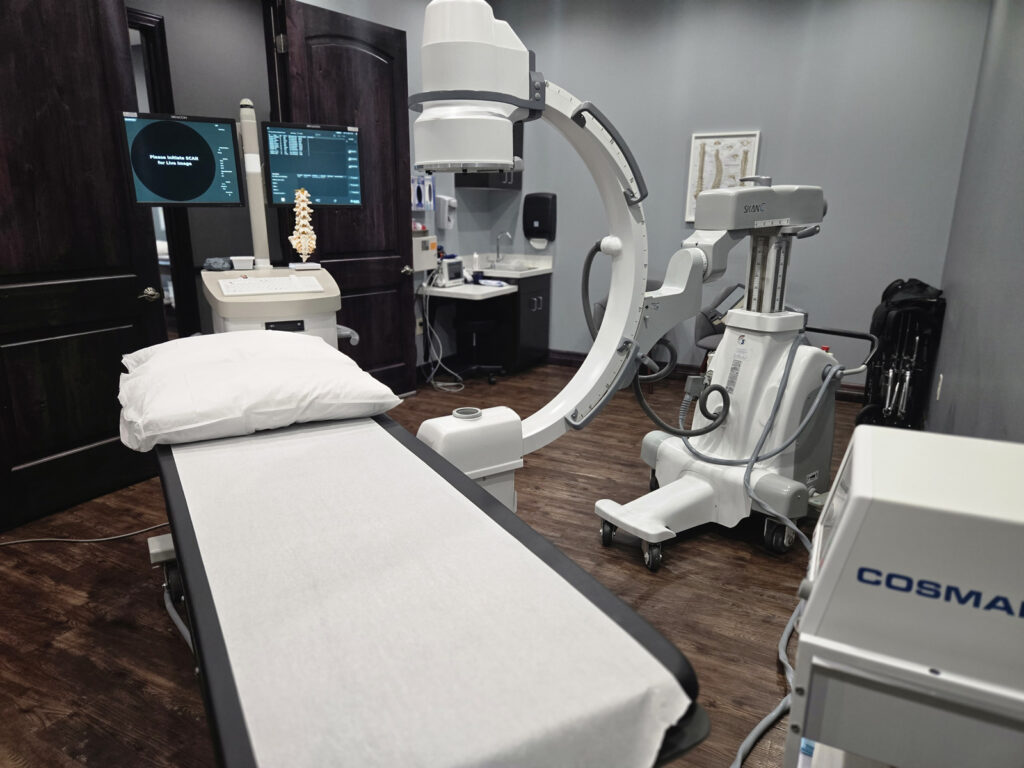Radiofrequency Lesioning (RFL)
What Is Radiofrequency Lesioning (RFL)?
Lasting Relief Through Nerve Treatment
Radiofrequency lesioning (also called radiofrequency ablation) uses controlled heat to interrupt the medial branch nerves that carry pain signals from your facet joints.
By creating a tiny, precise lesion on these nerves, we can “turn down the volume” on pain so you can move more comfortably and get back to the activities you enjoy.
Unlike temporary injections, RFL commonly provides relief for six to twelve months, and sometimes longer as nerves slowly regenerate.

How Nerve Pain Develops?
When the joints in the spine (facet joints) become arthritic or inflamed, they irritate the small medial branch nerves that supply them. These irritated nerves continuously send pain signals to the brain, even when the underlying problem can’t be completely fixed. RFA interrupts this cycle by turning down those pain signals at their source.
Good To Know
- Not for everyone – RFA is most helpful for facet-related pain, not for disc herniations or every type of back pain.Not for everyone – RFA is most helpful for facet-related pain, not for disc herniations or every type of back pain.
How The Procedure Works
1) Preparation
We review your history, clean the area, and use local anesthetic for comfort.
2) Precision Targeting
Under fluoroscopy (x-day), a thin probe is positioned next to the medial branch nerves. Small electrical pulses confirm the correct nerve location.
3) Gentle Heating
Controlled radiofrequency energy creates a small lesion that interrupts the pain signal pathway.
Benefits & Who It Helps
- Longer relief than injections alone
- Minimally invasive; no surgery
- Can reduce reliance on daily pain meds
- Repeatable when pain returns
Risks & Safety
Complications are uncommon. Short-lived effects may include soreness, bruising, or mild numbness around the treatment site. Serious complications are rare when the procedure is performed by an experienced pain physician.
Best candidates: Patients who had meaningful but temporary relief from a Medial Branch Block and have facet-related neck or low back pain not fully relieved by medication, PT, or chiropractic care.
Next Steps
If diagnostic injections such as medial branch blocks have provided relief, radiofrequency lesioning may be the next step to achieve longer-lasting pain control. At Williamson Pain Institute, we carefully evaluate each patient to determine if this advanced treatment is right for you.
Contact us today to schedule a consultation and learn more about radiofrequency lesioning.
Insurance accepted. Most plans, including Medicare, cover radiofrequency lesioning when medically necessary. Our office will verify your benefits.

Your Questions Answered
Radiofrequency lesioning uses controlled heat to interrupt the small medial branch nerves that carry pain from the facet joints. This helps reduce pain signals and improve mobility.
RFL works best if you had meaningful but temporary relief from a Medial Branch Block. It’s typically used for facet-related neck or low back pain that hasn’t responded to medication, physical therapy, or chiropractic care.
Most RFL procedures take about 30–45 minutes, plus a short recovery period in the office before you go home the same day.
Relief builds gradually over 1–3 weeks as the targeted nerves quiet down. Some patients notice improvement sooner; others take a bit longer.
Relief commonly lasts 6–12 months, sometimes longer. Nerves can slowly regrow; if pain returns, RFL may be repeated after re-evaluation.
Short-lived soreness, bruising, or mild numbness near the treatment area can occur. Serious complications are uncommon when performed by an experienced pain physician.
Yes. Radiofrequency lesioning is another term for radiofrequency ablation (RFA). Both describe using radiofrequency energy to create a small, precise lesion on the medial branch nerves.
Many patients do well with a single session on the affected level(s). If pain returns as nerves regrow, RFL can be safely repeated when appropriate.
We’ll review your medical history. Let us know about active infections, bleeding disorders, certain implanted devices, or pregnancy so we can tailor a safe plan.
